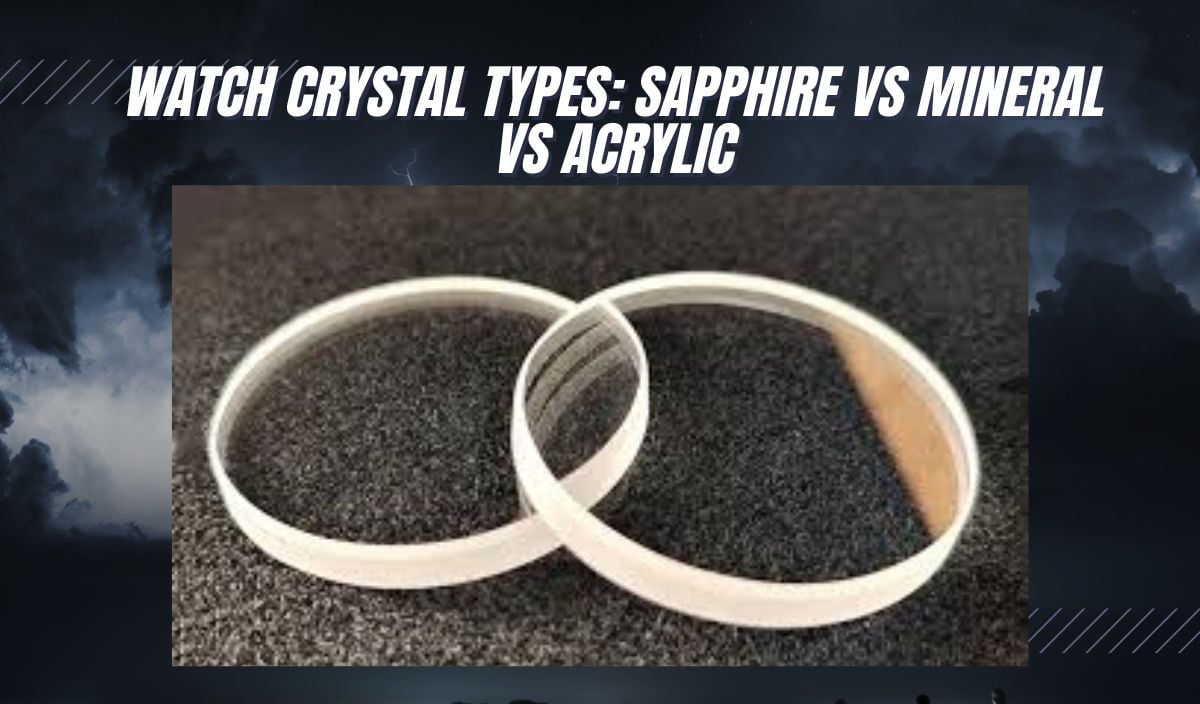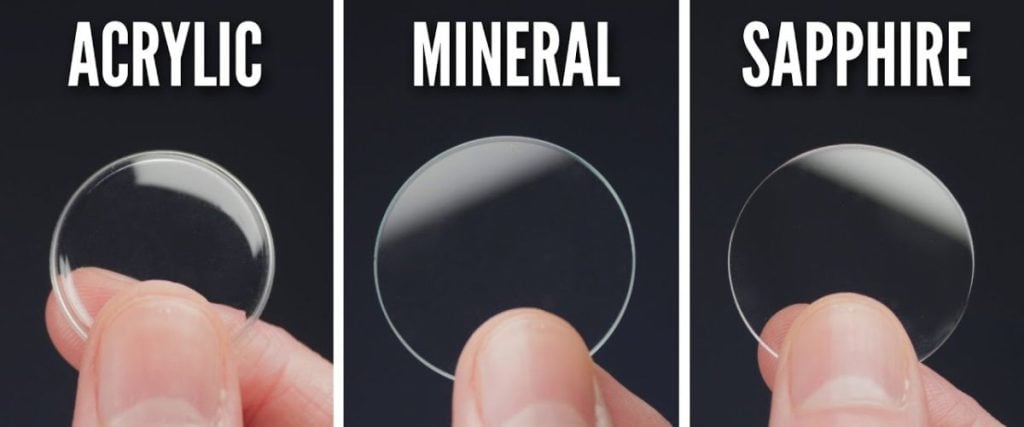
Watch Crystal Types: Sapphire vs Mineral vs Acrylic

We’ll forgive you if you haven’t thought much about your watch’s crystal. At the end of the day, this thing is almost entirely transparent so it’s not going to be the first thing you notice. That clear thing covering the dial does a lot more than you might expect, however. But isn’t it just glass? Well, yes… and no. That “glass” is actually called watch crystal, and it does a lot more than just look pretty.
It’s a little like your watch’s armor, and it greatly affects how tough your watch is, how clear the dial looks and importantly, how much you’ll be shelling out for the timepiece at checkout. If you’ve owned watches in the past, it’s likely you’ve noticed scratches popping up on some watch crystals more than others, or you’ve noticed some watch crystals looking perfectly clear while others can be a little cloudy. That’s because not all watch crystals are the same.
In fact, there are three types of main watch crystal types: sapphire crystal, mineral crystal and acrylic. Each has its own superpowers and its own weaknesses, so the type you choose can make a real difference in your watch’s durability and aesthetic. In this guide, we’ll be breaking down these three crystal types for you. We’ll walk you through the pros and cons of each, so you can make the right decision for you when it comes to choosing your next timepiece.
The Acrylic Crystal
Alright, let’s get into the wonderful, occasionally scratchy world of acrylic glass! I like to think of acrylic glass as the humble, hardworking, and slightly underappreciated material that covers the face of many watches. While it might not be as flashy as sapphire or as refined as mineral glass, acrylic is a classic choice for a reason.
What Exactly Is Acrylic Glass?
First things first, despite being called “acrylic glass,” it’s not glass at all. Acrylic is actually a type of plastic, specifically polymethyl methacrylate (or PMMA if you’re feeling fancy). You might also hear it called Plexiglas or plexiglass. It’s lightweight, clear as can be, and is used for watch crystals because it shares some glass-like optical properties while being a lot easier on the wallet. It’s been a go-to material in watchmaking for decades and is especially common in vintage watches since it was used a lot more regularly during the 70’s and 80’s.
A Quick History of Acrylic in Watchmaking
Acrylic glass, or PMMA, was first developed in the 1920s by British chemists Rowland Hill and John Crawford, who were working with the company Imperial Chemical Industries. It was later introduced commercially in 1933 by the German company Röhm and Haas under the trade name Plexiglas. This material became especially popular due to its unique combination of transparency, durability, and lightweight properties, mimicking the appearance of glass but with greater resistance to impact and lower cost.
Its early uses were mainly industrial and military. For example, during World War II, acrylic glass was widely used in aircraft canopies, submarine periscopes, and even gun turrets, valued for its impact resistance and transparency. After the war, acrylic became more accessible and was adapted for consumer products, including watch crystals. It first appeared on watches around the 1950s, and quickly became a standard material, especially throughout the 1970s and 1980s.
Pros of Acrylic Glass
· Impact Resistance – One of the top reasons acrylic has stuck around for so long is its durability. Unlike glass, which can crack or shatter, acrylic is more flexible and can absorb a hit without falling to pieces. This makes it ideal for sports or outdoor watches and any watch likely to see some rough handling. It’s why a lot of smartwatch brands tend to use acrylic glass on their designs, because it’s best for those that like to go hiking or jump out of planes. It can take a beating without flinching.
· Light as a Feather – Acrylic glass is noticeably lighter than other crystal materials like mineral glass or sapphire, making it super comfortable to wear. If you’re after an everyday watch that doesn’t feel like a weight on your wrist, acrylic is a solid choice. Less weight on your wrist means it’s most likely going to be more comfortable.
· Cost-Effective Choice – Acrylic glass is cheaper to produce than other crystal types, so it’s often found in more affordable watches. This means you can get a stylish, functional watch without spending a fortune, which is great news for newcomers to the watch world or anyone looking to expand their collection on a budget.
· Easy to Polish – While acrylic might scratch more easily than other materials (we’ll get to that in a minute), it has a secret weapon: you can polish those scratches away! With a little bit of polishing, acrylic crystals can be buffed back to clear, like-new condition. No need for costly replacements or worrying about every little nick or scuff—just polish, and it’s like they were never there.
Cons of Acrylic Glass
· Scratch-Prone – Despite acrylic happily taking a strong hit without cracking, it can be pretty easy to scratch. Toss it in your pocket with your keys, or brush it up against a rough surface, and it’s likely to come away with a few marks. But as we mentioned earlier, scratches on acrylic are generally fixable with a quick polish. However, if you’re someone who wants a completely scratch-free watch face all the time, acrylic might drive you a little nuts.
· Looks a Bit “Cheap” – At the end of the day, acrylic is plastic, and it sometimes lacks the high-end look that mineral or sapphire crystal can give a watch. Especially when you hold it up next to sapphire, it can seem a little less sophisticated or luxe. That said, plenty of watch lovers appreciate the retro, warm look that acrylic gives, so this really comes down to personal taste.
The Mineral Crystal
Now, let’s talk about mineral glass, the reliable middle ground of watch crystals. Mineral glass is probably the most common glass you’ll find on mid-range watches, giving you a solid blend of durability, affordability, and clarity.
What Exactly is Mineral Glass?
This time mineral glass is, as its name suggests, a type of glass. But it’s not just any old glass like what our drinking glasses are made of. It’s toughened up with a process called tempering (or hardening) where the glass is heated to high temperatures and then cooled rapidly. This treatment strengthens the glass, making it harder and more resistant to scratches and impacts than regular glass. It won’t take on sapphire crystal in terms of hardness, but it’s got way more scratch resistance than acrylic.
A Quick History of Mineral Glass
Mineral glass began making its way into watches during the mid-20th century, as watchmakers were looking for a stronger alternative to acrylic that was still cost-effective. By the 1970s and 1980s, mineral glass was all over the place in the watch world, quickly becoming the industry standard for most mid-range models. Its clarity, scratch resistance, and lower price point helped mineral glass become a favorite among both brands and buyers alike. Interestingly, there is no inventor credited to the creation of mineral glass but many accessible watch brands, like Seiko and Citizen, are known for playing a significant role in popularizing the material.
Pros of Mineral Glass
· Scratch Resistance – One of mineral glass’s big selling points is its scratch resistance. While not as tough as sapphire, mineral glass is sturdy enough to handle everyday knocks and scrapes without showing too much wear. If you’re careful with your watch but still want something resilient enough for regular use, mineral glass strikes a good balance. It’s definitely more scratch-resistant than acrylic, so it doesn’t need constant touch-ups to stay looking nice and clear.
· Cost-Effective – Mineral glass is affordable to produce, which keeps prices down on watches that use it. This makes it a popular choice for budget-conscious watch collectors who want durability without breaking the bank. You get a quality crystal that offers some resistance to scratching and impact, all while keeping your wallet happy.
· Clear as Day – Mineral glass is known for its optical clarity, allowing you to see your watch’s dial and hands clearly. In some cases, it’s even coated with an anti-reflective (AR) layer, so you get an extra-clear view without those annoying reflections. This is especially nice if you’re outdoors a lot or tend to check the time in bright settings, as it keeps the dial sharp and easy to read.
Cons of Mineral Glass
· Prone to Scratches (Eventually) – While mineral glass is more scratch-resistant than acrylic, it’s not invincible. With daily wear, it may eventually collect some fine scratches, especially if you’re around abrasive surfaces a lot. Unlike acrylic, which can be polished back to perfection, mineral glass scratches are tough to remove, so it’s best to be a little cautious if you want it to stay pristine.
· Risk of Breaking and Shattering – Mineral glass is toughened, but it’s still glass at the end of the day. Under heavy impact, it can crack or shatter, which makes it a bit more vulnerable than sapphire, which has both greater scratch and shatter resistance. If you’re looking for ultimate durability and are willing to invest a little more, you might want to consider sapphire instead.
The Sapphire Crystal
Finally, we have sapphire crystal glass which, to be completely honest, it the crème-de-la-crème of watch crystals. It’s known for being insanely tough, ultra-scratch resistant and has a beautiful sheen to it that makes reading watch dials effortless. Its hardness is only second to diamonds (the hardest material known to man).
What Exactly Is Sapphire Crystal?
Sapphire crystal isn’t glass, but a synthetic material made from aluminum oxide which is the same stuff as sapphire gemstones. But rather than being blue or pink as we best know sapphires, it is its clearest form. To make it, they use a process called the Verneuil method which involves heating up aluminum oxide crystals to super-high temperatures and then forming them into a transparent, super-durable material. Then it’s cut, polished, and shaped to fit your watch.
A Quick History of Sapphire Crystal
Sapphire crystal was introduced during the early 1900’s but was originally used for industrial purposes, like in scientific instruments and camera lenses. It wasn’t until the 1960s and 70s that watchmakers started catching on and using it for watch crystals. It’s thought that one of the first watches to use sapphire crystal was Jaeger-LeCoultre in the 1930’s with the Swiss watchmaker placing it on their iconic Reverso watch. But really, it was Rolex that first used it extensively, spurring the material to be a widespread material with models like the Rolex Daytona in the 1980’s. Today, sapphire crystal is incredibly popular in many watches, notably those in the luxury category.
Pros of Sapphire Crystal
· Harder Than a Rock: Seriously, sapphire crystal is tough. It ranks a 9 on the Mohs scale (with the diamond ranked at 10), which means it’s almost impossible to scratch. Owning a sapphire crystal watch means you rarely have to worry about getting any scratches or cracks at all.
· Crystal Clear: Sapphire crystal is known for its amazing clarity. You’ll get no fog, no distortion – just a perfect, clear view of your watch dial. It’s like looking through a sheet of glass that’s been perfectly polished.
· Low Maintenance: Unlike acrylic and mineral glass, which can scratch over time, sapphire stays flawless for way longer. That means fewer trips to the watch shop for polishing and cleaning.
· Chemical Resistant: We’re all prone to being a little clumsy, so if you accidently splash coffee or hand sanitizer on your watch, you can feel assured that sapphire crystal is resistant to most chemicals.
· That Luxe Look: Finally, watches with sapphire crystal just look more premium. It has this beautiful shine that gives the watch a high-end vibe. This is especially clear when you place a sapphire crystal watch next to one made of acrylic.
Cons of Sapphire Crystal
· A Little Brittle: Despite sapphire crystal being incredibly hard, it’s not entirely “shatterproof.” It could still chip or crack if you drop it or hit it hard against a solid surface. So, as tough as it is on scratches, it’s a little more delicate in the impact department.
· Price Tag: Sapphire crystal is expensive to make. So, watches with sapphire crystal are generally pricier. It’s why you’ll always find sapphire crystal glass on top-end watches like those from Omega, Rolex and Patek Phillippe. It’s the best of the best, so it’s used by the best of the best.
Explore the
Biggest Pre-Owned Collection of Luxury Watches
· No Fixing Scratches: Unlike acrylic glass, which can be polished if it gets a scratch, sapphire doesn’t really “polish” the same way. Once it gets a scratch, you’re stuck with it until you’re willing to replace the entire crystal.
Why is the Watch Crystal Important?
That clear shiny piece of crystal that sits on top of your watch dial is incredibly important, we promise. It might seem like a small thing, but the right crystal can make a huge difference to how your watch wears, looks and lasts.
First off, watch crystals are your watch’s first line of defense. It’s the material that will take the hit when you accidentally knock your watch on a doorframe or drop it on the floor. If you pick a cheap, soft crystal like acrylic, you’re likely going to be dealing with scratches every few months. On the other hand, sapphire crystal is almost indestructible. It won’t get scratched up anywhere near as easily, keeping your watch looking fresh and sharp for much longer.
Next, there’s clarity. If you want a watch that looks as clear and shiny as it does in the store, you’ve got to think about the crystal. Sapphire gives you an unbeatable view of the dial with no distortion. Mineral glass and acrylic glass are still breathtakingly clear, but since they scratch a lot easier, they can eventually get an almost “hazy” effect which will in turn affect the legibility of the dial.
Then there’s the cost. Sure, you might love the idea of rocking a Grand Seiko with sapphire crystal, but if you’re on a budget, mineral glass or even acrylic might be the way to go. Just keep in mind that these cheaper options may scratch more easily and might need some more TLC. Instead, if you’re someone who wants low-maintenance gear, then investing in sapphire might save you hassle in the long run.
Finally, style matters too. Watch crystal plays a big role in the aesthetics of your watch. A crystal with that perfect shine with little to not scratches will undoubtedly elevate the whole vibe of your watch.
Conclusion
At the end of the day, the type of watch crystal that’s best for you really depends on your personal style, lifestyle, and budget. If it were me, I’d save up a bit more for sapphire crystal since it’s super durable, scratch-resistant, and looks amazing. But I totally get that not everyone wants to drop that much on a watch, and that’s okay. Acrylic and mineral glass can still look great and hold up well if you take care of them. It’s all about finding the right balance that works for you.
About Exquisite Timepieces
Established in 1998, Exquisite Timepieces is your one-stop shop for all things luxury watches! We are an authorized dealer for 60+ luxury watch brands including Omega, Hublot, Seiko, & Longines! We are proud to showcase one of the world’s largest pre-owned watch collections, including renowned brands like Rolex and Patek Philippe. Check out our brand new watch arrivals here and popular pre-owned listings here.




















